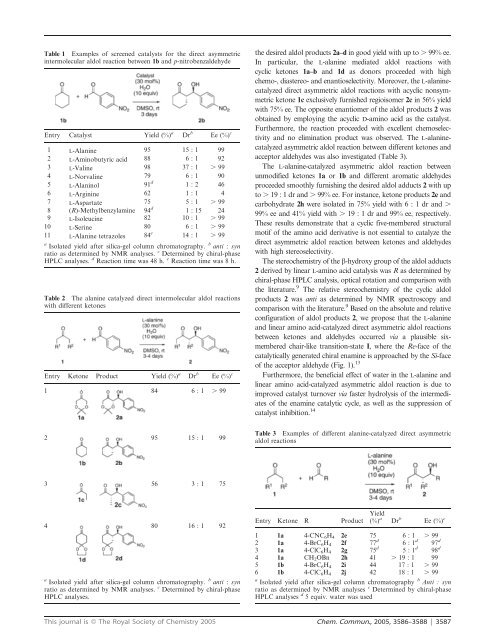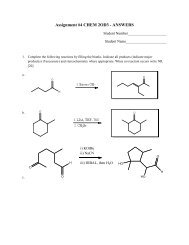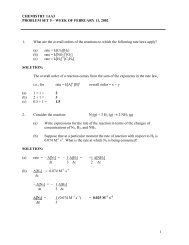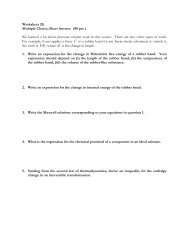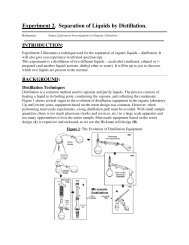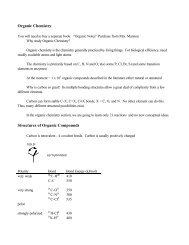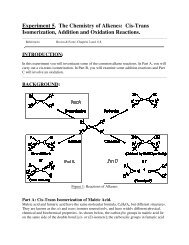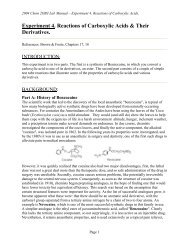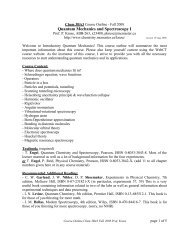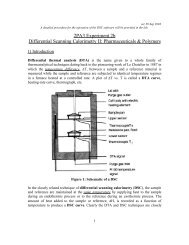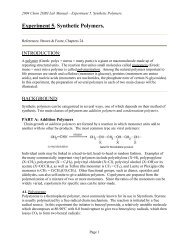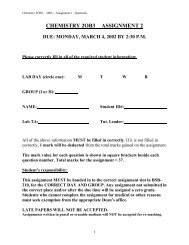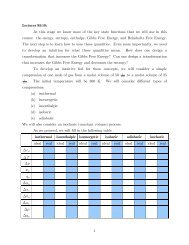Table 1 Examples of screened catalysts for the <strong>direct</strong> <strong>asymmetric</strong>intermolecular aldol reaction between 1b and p-nitrobenzaldehydeEntry Catalyst Yield (%) a Dr b Ee (%) c1 L-Alanine 95 15 : 1 992 L-Aminobutyric <strong>acid</strong> 88 6 : 1 923 L-Valine 98 37 : 1 . 994 L-Norvaline 79 6 : 1 905 L-Alaninol 91 d 1:2 466 L-Arginine 62 1 : 1 47 L-Aspartate 75 5 : 1 . 998 (R)-Methylbenzylamine 94 d 1 : 15 249 L-Isoleucine 82 10 : 1 . 9910 L-Serine 80 6 : 1 . 9911 L-Alanine tetrazoles 84 e 14 : 1 . 99a Isolated yield after silica-gel column chromatography. b anti : synratio as determined by NMR analyses. c Determined by chiral-phaseHPLC analyses. d Reaction time was 48 h. e Reaction time was 8 h.Table 2 The alanine <strong>catalyzed</strong> <strong>direct</strong> intermolecular aldol reactionswith different ketonesEntry Ketone Product Yield (%) a Dr b Ee (%) c1 84 6 : 1 . 99the desired aldol products 2a–d ingoodyieldwithupto. 99% ee.In particular, the L-alanine mediated aldol reactions withcyclic ketones 1a–b and 1d as donors proceeded with highchemo-, diastereo- and enantioselectivity. Moreover, the L-alanine<strong>catalyzed</strong><strong>direct</strong> <strong>asymmetric</strong> aldol reactions with acyclic nonsymmetricketone 1c exclusively furnished regioisomer 2c in 56% yieldwith 75% ee. The opposite enantiomer of the aldol products 2 wasobtained by employing the acyclic D-<strong>amino</strong> <strong>acid</strong> as the catalyst.Furthermore, the reaction proceeded with excellent chemoselectivityand no elimination product was observed. The L-alanine<strong>catalyzed</strong><strong>asymmetric</strong> aldol reaction between different ketones andacceptor aldehydes was also investigated (Table 3).The L-alanine-<strong>catalyzed</strong> <strong>asymmetric</strong> aldol reaction betweenunmodified ketones 1a or 1b and different aromatic aldehydesproceeded smoothly furnishing the desired aldol adducts 2 with upto . 19 : 1 dr and . 99%ee.Forinstance,ketoneproducts2e andcarbohydrate 2h were isolated in 75% yield with 6 : 1 dr and .99% ee and 41% yield with . 19 : 1 dr and 99% ee, respectively.These results demonstrate that a cyclic five-membered structuralmotif of the <strong>amino</strong> <strong>acid</strong> derivative is not essential to catalyze the<strong>direct</strong> <strong>asymmetric</strong> aldol reaction between ketones and aldehydeswith high stereoselectivity.The stereochemistry of the b-hydroxy group of the aldol adducts2 derived by linear L-<strong>amino</strong> <strong>acid</strong> catalysis was R as determined bychiral-phase HPLC analysis, optical rotation and comparison withthe literature. 9 The relative stereochemistry of the cyclic aldolproducts 2 was anti as determined by NMR spectroscopy andcomparison with the literature. 9 Basedontheabsoluteandrelativeconfiguration of aldol products 2, we propose that the L-alanineand linear <strong>amino</strong> <strong>acid</strong>-<strong>catalyzed</strong> <strong>direct</strong> <strong>asymmetric</strong> aldol reactionsbetween ketones and aldehydes occurred via a plausible sixmemberedchair-like transition-state I, wheretheRe-face of thecatalytically generated chiral enamine is approached by the Si-faceof the acceptor aldehyde (Fig. 1). 13Furthermore, the beneficial effect of water in the L-alanine andlinear <strong>amino</strong> <strong>acid</strong>-<strong>catalyzed</strong> <strong>asymmetric</strong> aldol reaction is due toimproved catalyst turnover via faster hydrolysis of the intermediatesof the enamine catalytic cycle, as well as the suppression ofcatalyst inhibition. 142 95 15 : 1 99Table 3 Examples of different alanine-<strong>catalyzed</strong> <strong>direct</strong> <strong>asymmetric</strong>aldol reactions3 56 3 : 1 754 80 16 : 1 92a Isolated yield after silica-gel column chromatography. b anti : synratio as determined by NMR analyses. c Determined by chiral-phaseHPLC analyses.Entry Ketone R ProductYield(%) a Dr b Ee (%) c1 1a 4-CNC 6 H 4 2e 75 6 : 1 . 992 1a 4-BrC 6 H 4 2f 77 d 6:1 d 97 d3 1a 4-ClC 6 H 4 2g 75 d 5:1 d 98 d4 1a CH 2 OBn 2h 41 . 19 : 1 995 1b 4-BrC 6 H 4 2i 44 17 : 1 . 996 1b 4-ClC 6 H 4 2j 42 18 : 1 . 99a Isolated yield after silica-gel column chromatography b Anti : synratio as determined by NMR analyses c Determined by chiral-phaseHPLC analyses d 5 equiv. water was usedThis journal is ß The Royal Society of Chemistry 2005 Chem. Commun., 2005, 3586–3588 | 3587
Fig. 1 Plausible transition state I for the primary <strong>amino</strong> <strong>acid</strong>-<strong>catalyzed</strong><strong>asymmetric</strong> aldol reactions between ketones and aldehydes.In summary, we have demonstrated that linear <strong>amino</strong> <strong>acid</strong>s andtheir derivatives can be of synthetic use as catalysts for the <strong>direct</strong><strong>asymmetric</strong> intermolecular aldol reaction. For example, alanine,valine, aspartate, isoleucine, alanine tetrazole 3 and serine<strong>catalyzed</strong> the <strong>direct</strong> <strong>asymmetric</strong> aldol reactions with excellentstereoselectivity, and furnished the corresponding b-hydroxyketonesinhighyieldandupto. 99% ee. The linear <strong>amino</strong><strong>acid</strong>- and amine-<strong>catalyzed</strong> reactions are accelerated by water, andare inexpensive, operationally simple and environmentally benign.Importantly, our study demonstrates that a cyclic five-memberedringmotifinthe<strong>amino</strong><strong>acid</strong>catalystisnotessentialforachievinghigh <strong>asymmetric</strong> induction of the aldol products. Thus, severalsimple linear natural and nonproteogenic <strong>amino</strong> <strong>acid</strong>s and theirderivatives can be used as catalysts for this important <strong>asymmetric</strong>reaction, which will dramatically expand the structural diversitythat can be utilized in the design of novel organocatalysts. In fact,asimplea-methyl group of an <strong>amino</strong> <strong>acid</strong> is enough to reach theexcellent stereoselectivity of natural aldolase enzymes. Furtherexpansion of the use of linear <strong>amino</strong> <strong>acid</strong>s and their derivatives inorganocatalytic <strong>asymmetric</strong> C–C bond-forming reactions, mechanisticstudies and density functional theory calculations is ongoing.We gratefully acknowledge the Swedish National ResearchCouncil, Carl-Trygger Foundation, Lars-Hierta Foundation andWenner-Gren Foundation for financial support.Notes and references1 (a) W.-D. Fessner, in Stereoselective Biocatalysis; R.N.Patel,Ed.;Marcel Dekker, New York, 2000, p. 239; (b) T. D. Machajewski andC.-H. Wong, Angew. Chem., Int. Ed., 2000, 39, 1352.2 Comprehensive Organic Synthesis, Vol. 2,B.M.Trost,I.Fleming,C.-H.Heathcock, Eds.; Pergamon, Oxford, 1991.3 For examples of application in total synthesis see: (a) T.Mukaiyama,Angew. Chem., Int. Ed., 2004, 43, 5590; (b) K. C. Nicolaou,D. Vourloumis, N. Winssinger and P. S. Baran, Angew. Chem., Int.Ed., 2000, 39, 44.4 Modern Aldol Reactions, Vol. 1 & 2, R. Mahrwald, Ed.; Wiley-VCH,Weinheim, 2004; E. M. Carreira, in Comprehensive AsymmetricCatalysis; E.N.Jacobsen,A.Pfaltz,H.Yamamoto,Eds.;Springer,Heidelberg, 1999; J. S. Johnson and D. A. Evans, Acc. Chem. Res.,2000, 33, 325.5 (a) K. Mikami and S. Matsukawa, J. Am. Chem. Soc., 1994, 116, 4077;(b) G.E.Keck,X.-Y.LiandD.Krishnamurthy,J. Org. Chem., 1995,60, 5998; (c) D.A.Evans,D.M.Fitch,T.E.SmithandV.J.Cee,J. Am. Chem. Soc., 2000, 122, 10033; (d) K. Juhl, N. Gathergood andK. A. Jørgensen, Chem. Commun., 2000, 2211; (e) E. M. Carreira,R. A. Singer and W. S. Lee, J. Am. Chem. Soc., 1994, 116, 8837; (f)H. Ishita, Y. Yamashita, H. Shimizu and S. Kobayashi, J. Am. Chem.Soc., 2000, 122, 5403; (g) S. E. Denmark and R. A. Stavanger, J. Am.Chem. Soc., 2000, 122, 8837; (h) N. Kumagai, S. Matsunaga,T.Kinoshita,S.Harada,S.Okada,S.Sakamoto,K.YamaguchiandM. Shibasaki, J. Am. Chem. Soc., 2003, 125,2169;(i)B.M.Trost,H.ItoandE.R.Silcoff,J. Am. Chem. Soc., 2001, 123, 3367; (j) Y.M.A.Yamada,N.Yoshikawa,H.SasaiandM.Shibasaki,Angew. Chem.,Int. Ed., 1997, 36, 1871; (k) D. A. Evans, C. W. Downey andJ. L. Hubbs, J. Am. Chem. Soc., 2003, 125, 8706.6 R. Schoevaart, F. Van Rantwijk and R. A. Sheldon, J. Org. Chem.,2000, 65, 6940; H. J. M. Gijsen, L. Qiao, W. Fitz and C.-H Wong,Chem. Rev., 1996, 96, 443.7 Reviews see: P. I. Dalko and L. Moisan, Angew. Chem., Int. Ed., 2004,43, 5138; B. List, Tetrahedron, 2002, 58, 5573.8 For the proline-<strong>catalyzed</strong> intermolecular aldol reaction see: (a)Z. G. Hajos and D. R. Parrish, J. Org. Chem., 1974, 39, 1615;(b)U. Eder, R. Sauer and R. Wiechert, Angew. Chem., Int. Ed., 1971, 10,496; (c)C.Pidathala,L.Hoang,N.VignolaandB.List,Angew. Chem.,Int. Ed.,2003,42, 2785. For the stoichiometric use of phenylalanine andtyrosine to mediate <strong>asymmetric</strong> intermolecular aldol condensations see:(d) S. Danishefsky and P. Cain, J. Am. Chem. Soc., 1975, 97, 5282; (e)I. Shimizu, Y. Naito and J. Tsuji, Tetrahedron Lett., 1980, 21, 4975; (f)H. Hagiwara and H. Uda, J. Org. Chem.,1988,53, 2308; (g)E.J.Coreyand S. C. Virgil, J. Am. Chem. Soc., 1990, 112, 6429.9 (a) B. List, R. A. Lerner and C. F. Barbas, III, J. Am. Chem. Soc., 2000,122, 2395; (b) W. Notz and B. List, J. Am. Chem. Soc., 2000, 122, 7386;(c) K. S. Sakthivel, W. Notz, T. Bui and C. F. Barbas, III, J. Am. Chem.Soc., 2001, 123, 5260; (d) B. List, P. Porjarliev and C. Castello, Org.Lett., 2001,3, 573;(e) A.Córdova, W. Notz and C. F. Barbas, III,Chem. Commun., 2002, 3024; (f)A.Córdova, W. Notz and C. F. Barbas,III, J. Org. Chem., 2002, 67, 301; (g) A.B.NorthrupandD.W.C.MacMillan, J. Am. Chem. Soc., 2002, 124, 6798; (h) A. Bøgevig,N. Kumaragurubaran and K. A. Jørgensen, Chem. Commun., 2002,620; S. Saito, M. Nakadai and H. Yamamoto, Tetrahedron, 2002, 58,8167; (i) Z. Tang, F. Jiang, L.-T. Yu, X. Cui, L.-Z. Gong, A.-Q. Mi,Y.-Z. Jiang and Y.-D. Wu, J. Am. Chem. Soc., 2003, 125, 5262; (j)H. Torii, M. Nakadai, K. Ishihara, S. Saito and H. Yamamoto, Angew.Chem., Int. Ed., 2004, 43, 1983; (k) A. Hartikaa and P. I. Arvidsson,Tetrahedron: Asymmetry, 2004, 15, 1831; (l) A. Berkessel, B. Koch andJ. Lex, Adv. Synth. Catal., 2004, 346, 1141; (m) A. J. A. Cobb,D.M.Shaw,D.A.Longbottom,J.B.GoldandS.V.Ley,Org. Biomol.Chem., 2005, 3, 84.10 J. Casas, M. Engqvist, I. Ibrahem, B. Kaynak and A. Córdova, Angew.Chem., Int. Ed., 2005, 44, 1343;A.Córdova, H. Sundén,M.Engqvist,I. Ibrahem and J. Casas, J. Am. Chem. Soc., 2004, 126, 8914;A. Córdova, Acc. Chem. Res., 2004, 37, 102; H. Sundén,M.Engqvist,J. Casas, I. Ibrahem and A. Córdova, Angew. Chem., Int. Ed., 2004, 43,6532;A.Córdova,I.Ibrahem,J.Casas,H.Sundén,M.EngqvistandE. Reyes, Chem.Eur.J., 2005, 11, 4772;A.Córdova,M.Engqvist,I. Ibrahem, J. Casas and H. Sundén, Chem. Commun., 2005, 2047.11 Alanine is also the oldest chiral <strong>amino</strong> <strong>acid</strong> incorporated in the proteinevolution, see: I. K. Jordan, F. A. Kondrashov, I. A. Adzhubei,Y.I.Wolf,E.V.Koonin,A.S.KondrashovandS.Sunyaev,Nature,2005, 433, 633. And it is also of extraterrestrial origin, see: J. R. Croninand S. Pizzarello, Science, 1997, 275, 951.12 For examples of the use of dihydroxyacetone mimetic 2a in proline<strong>catalyzed</strong>reactions see: (a) D. Enders and C. Grondal, Angew. Chem.,Int. Ed., 2005, 44, 1210; (b) I.IbrahemandA.Córdova, TetrahedronLett., 2005, 46, 3363. Performing the L-alanine-<strong>catalyzed</strong> reactionwithout addition of water enabled the isolation of 2a in 55% yield with2:1drand. 99% ee after 20 days.13 The stereochemical outcome of the acyclic L-<strong>amino</strong> <strong>acid</strong>-<strong>catalyzed</strong><strong>asymmetric</strong> aldol reactions between ketones and aldehydes was the sameas when L-proline was used as the catalyst, see: L. Hoang, S. Bahmanyar,K. N. Houk and B. List, J. Am. Chem. Soc., 2003, 125, 16.14 This beneficial effect of water has also been observed in proline and itsderivatives-<strong>catalyzed</strong> aldol reactions. See: reference 12b and (a) B.List,L. Hoang and H. J. Martin, Proc.Natl.Acad.Sci.USA,2004,101,5839; (b) A. I. Nyberg, A. Usano and P. Pihko, Synlett, 2004, 1891; (c)D. E. Ward and V. Jheengut, Tetrahedron Lett., 2004, 45, 8347.3588 | Chem. Commun., 2005, 3586–3588 This journal is ß The Royal Society of Chemistry 2005


